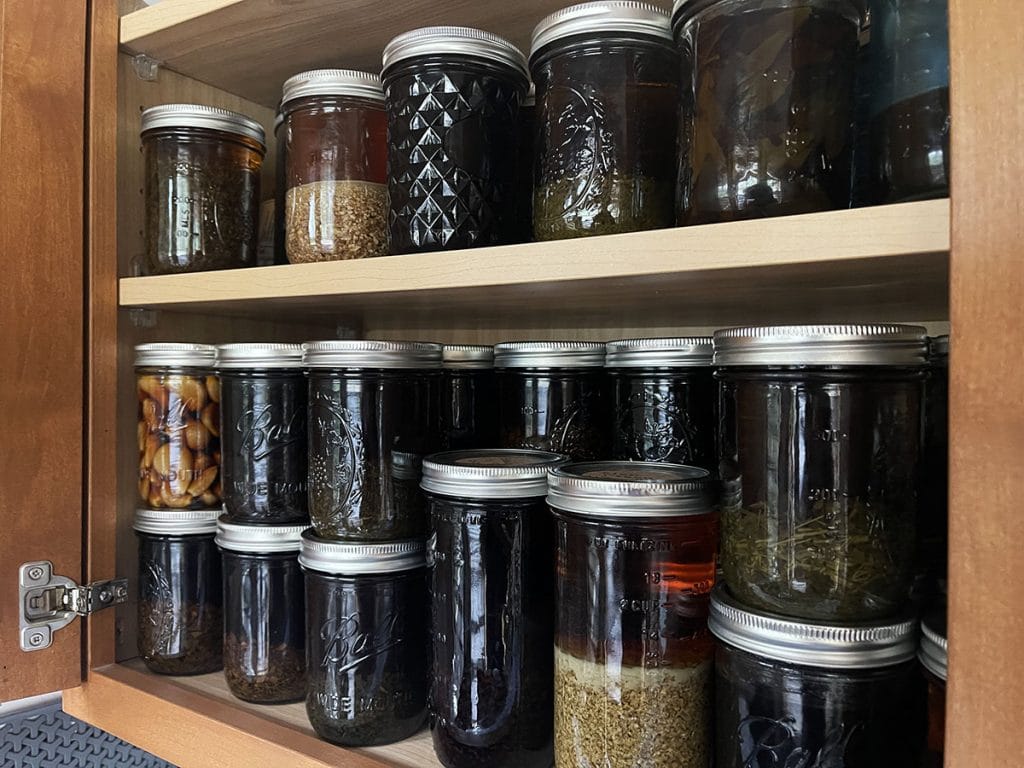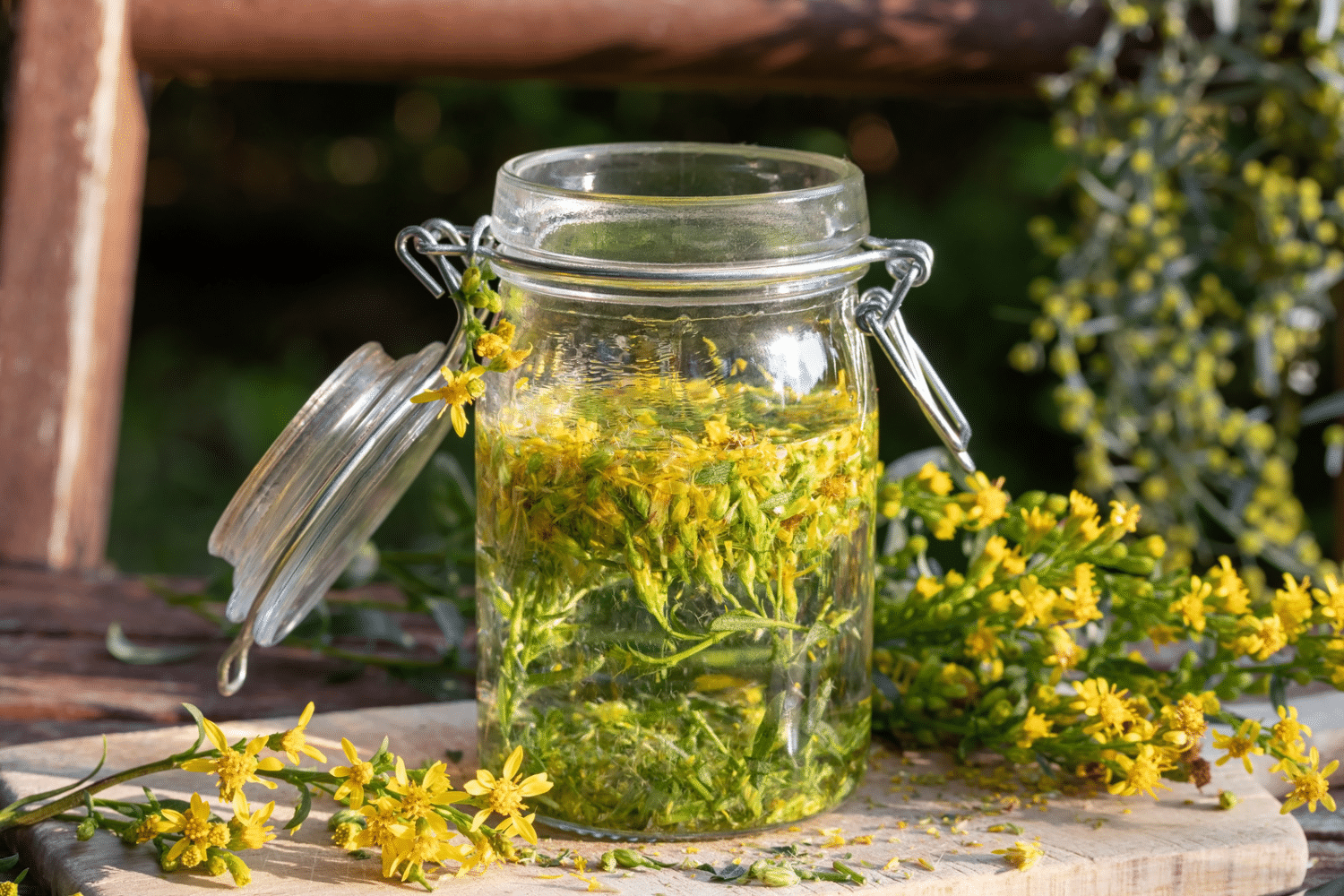Next to tisanes (aka herbal teas), tinctures are probably the most commonly used therapeutic herbal preparation. They’re a convenient and powerful way to incorporate herbs into your daily routine — effective, portable and easy to dose since you typically only take a few drops at a time diluted in water.
A tincture is a type of herbal extract made via the process of maceration, which simply means soaking herbs in a solvent for a certain amount of time until the properties of the herbs are drawn out into the liquid.
I didn’t explicitly say so in my earlier posts, but herbal bitters are a type of alcohol tincture. So if you tried either of my grapefruit or cardamom bitters recipes, then you’ve already made your first tincture! (Woot!)
Tincturing with alcohol is an excellent way to preserve the potency of your herbs, since herbs remain potent in alcohol tinctures for years, while dried herbs lose their potency long before that. Taste will help you determine if your tinctures are still potent.
Types of tinctures
Alcohol is an effective solvent for capturing a wide range of a plant’s phytochemicals, and it’s usually what is meant when we talk about herbal tinctures, but it’s not the only option. Tinctures can also be made using vinegar or glycerin (aka a glycerite).
Certain tinctures, such as lobelia, work best as a compound tincture using both alcohol and vinegar, also known as an acetous tincture. In the case of lobelia, the addition of vinegar works to better draw out the plant’s alkaloids, which are its primary active constituents that act as an effective bronchodilator to relieve spasmodic respiratory conditions.
Glycerin, a sweet byproduct of soap making, is generally considered to be a poor menstruum for medicinal purposes, but they have their place — particularly when alcohol content is not desirable, such as when giving tinctures to children or pets. Glycerites will pull out some water soluble alkaloids, polysaccharides and most (water soluble) vitamins and minerals. Herbal glycerites are also useful for use in homemade lotions and cosmetics.
Where's the proof?
Alcohol such as vodka or Everclear is a combination of varying amounts of ethyl alcohol and water, depending on the “proof” alcohol you choose. To determine a spirit’s actual alcohol content, simply divide its proof number by half. So for example, vodka — which is typically 80 proof — contains 40% alcohol (80 ÷ 2 = 40), which leaves the remaining 60% to be water. Everclear is usually 151 proof (75.5% alcohol) or 190 proof (95% alcohol).
Generally speaking, alcohol is a superior solvent vs. water alone for extracting most plant constituents. That said, it’s a mistake to assume that higher proof is always better in tincturing. Besides being more expensive, remember that water is a solvent too. It also plays a role in pulling out certain water soluble constituents, so a 190-proof Everclear (i.e. 95% pure alcohol and very little water) is not necessarily going to yield a better, more potent medicine. The appropriate ratio of alcohol to water that most effectively extracts a plant’s constituents varies from plant to plant. For example, you’d want to use a higher proof alcohol for plant matter containing a lot of resin such as conifers or cottonwood buds.
For lower alcohol tinctures, choose distilled water to dilute your alcohol. Your solvent will be “filled” with herbal constituents extracted from the plant, so it makes sense that you want it to be as empty as possible to begin with. Distilled water contains no chlorine, fluoride, minerals or sediments, so it’s effectively “empty” and ready to be filled up by the extraction.
The same is true of flavored alcohols. Choose plain, unflavored spirits for maximum extraction power, since the flavorings will take up space in the menstruum that could be filled by valuable plant constituents.
Alcohol is ideal for tincturing plants containing lots of alkaloids, glycosides, resins and volatile (essential) oils. Here’s a (not-so-exhaustive) list of some of the herbs that lend themselves to alcohol tinctures:
- angelica
- astragalus
- anise
- black cohosh
- burdock
- calendula
- California poppy
- catnip
- cleavers
- conifers
- cottonwood buds
- dandelion
- echinacea
- elderflower
- elecampane
- eucalyptus
- feverfew
- gentian
- hawthorn
- hyssop
- lavender
- lemon balm
- licorice
- lobelia
- meadowsweet
- milk thistle
- motherwort
- mugwort
- nettle
- peppermint
- red clover
- rhubarb
- rosemary
- sage
- skullcap
- self heal
- St. John’s wort
- thyme
- valerian
- willow bark
- witch hazel
- yarrow
Folk method FTW
If you’re really into weighing and measuring, tincture formulas are typically expressed as weight : volume. So a 1:5 tincture translates to 1 part herb by weight to 5 parts menstruum by volume. The ratio is usually followed by a percentage, which indicates the percentage of alcohol used in the tincture.
For my purposes, I much prefer the lazy way, aka the ‘folk method’.
Unless you really need to know the exact mg of herb in every dropperful of tincture for precise dosing, the folk method of tincturing is the simplest and most practical way to make tinctures for the casual or home herbalist. With the folk method, the amount of herbs and alcohol is estimated rather than carefully weighed/measured and there’s no need for fancy or expensive equipment.
Herbal tinctures can be made with either fresh or dried plant material. Prepare your fresh herbs by finely chopping them or use an electric coffee grinder or mortar and pestle to reduce the size of dried herbs. They don’t have to be powdered, but try to expose as much plant surface area to the alcohol as possible for a faster, more efficient extraction.
When considering the strength of alcohol you’re going to use, consider that fresh plant matter will contain a certain amount of water. You can minimize the water introduced by allowing your fresh plants to wilt overnight before tincturing, but it will still contribute a bit of water to the extraction. This is not usually a big deal, unless your tincture is nearing the 20% minimum amount of alcohol necessary to preserve a tincture. For very low-alcohol tinctures, you might be better off sticking with dried herbs.
The general method is to fill your jar to the halfway mark with dried herbs, since it will absorb liquid and swell. Fill your jar to the top with fresh or lightly wilted herbs. Fill your jar to the top with alcohol/distilled water, taking care to make sure the plant matter stays beneath the water line.
Shake your tincture daily, helping all of the plant matter to come in contact with the solvent. How long the tincture takes to fully extract depends on the plant material used. Generally, your tincture will be ready to strain in two to three weeks, but a tough bark like cinchona, for example, is going to take longer than a delicate flower like elderflower.
Per Richo Cech, when the alcohol has taken on the color of and smells strongly of your herb, then you’re probably ready to press and strain the tincture.

Speed things up
If you’re in a hurry, you can also make your tincture stronger faster by letting it soak in the alcohol overnight, then throw everything in the blender. Remember, more surface area = a more efficient extraction. Blend it up and pour everything back into your jar. Leave the plant in the alcohol to let it continue infusing, and you’ll have a stronger tincture sooner.
As one of my herbal mentors Suzanne, “Queen Bee” Tabert often says, “Open ALL the plant’s doors and windows.” The more doors and windows you open — meaning the more finely you chop up the plant and break open its cellular structure — the more easily the menstruum will be able to extract all those good constituents we’re trying to capture.
Finishing up
When you’re ready to strain out the spent plant matter (aka the marc), there are a number of tools that are helpful in squeezing out every last drop of precious tincture. The easiest and least expensive way is to simply line a colander or mesh strainer with couple of layers of cheesecloth or muslin, gather the cloth into a ball and SQUEEZE. You can also use coffee filters or a French press if you have one. For a little added torque power, some herbalists use handheld potato ricer or, for larger batches, a tabletop wine press. Keep in mind, you may need to strain multiple times to remove all plant sediment from the tincture.
Once you’re satisfied with the clarity of your tincture, transfer to a clean glass bottle or jar with a tight-fitting lid — preferably an amber or dark colored bottle with UV protection, unless you’re planning to store your tinctures in a consistently dark space out of direct sunlight.
Tinctures are notorious for settling – the heavier alkaloids will eventually sink to the bottom of the bottle. Have you ever gotten to the last couple of doses in a tincture bottle and suddenly felt like you overdosed a bit? Yeah, that’s the settled alkaloids in action. To avoid that, be sure to SHAKE the tincture bottle ever time you use it. You can also add a small amount of food-grade glycerin (5% to 10%), which will help keep everything in solution.
And as always, PLEASE DON’T FORGET TO LABEL YOUR BOTTLES! Bare minimum: herb name, fresh or dried, alcohol/vinegar/glycerine % used plus the date. It’s just tragic (not to mention wasteful!) when you come across a random unlabeled jar of liquid you have no way to identifying. *sad trombone sound* You may also want to include info about the tincture’s purpose and dosing recommendations so you don’t have to look it up each time you want to use your tincture. ♥



2 Responses
For a woody dry root tincture- is there a benefit to warming the root in water before adding the alcohol? Like a double extraction- does the heat help extract more?
Great question! It depends on the solubility of the constituents you’re trying to harness. A traditional double extraction (making separate alcohol and hot water extractions, then combining them) is most useful when you’re trying to get both alcohol-soluble and water-soluble compounds. If your target compounds are primarily alcohol-soluble, a decoction might not add much benefit, but if your root has a lot of water soluble constituents, then a decoction could be very beneficial.